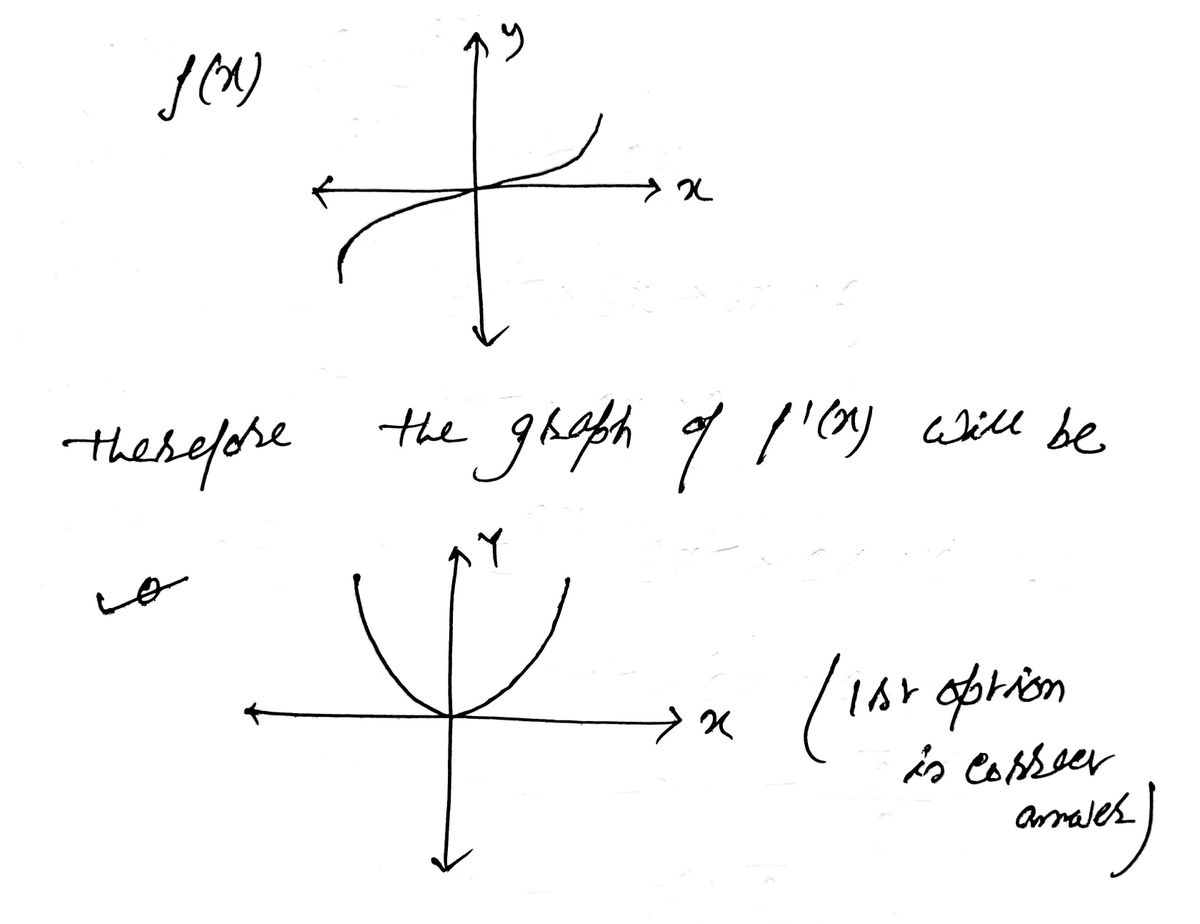Calculus: Early Transcendentals
8th Edition
ISBN:9781285741550
Author:James Stewart
Publisher:James Stewart
Chapter1: Functions And Models
Section: Chapter Questions
Problem 1RCC: (a) What is a function? What are its domain and range? (b) What is the graph of a function? (c) How...
Related questions
Topic Video
Question

Transcribed Image Text:**Question:**
Given the function \( f(x) \) shown, which is the graph of the derivative \( f'(x) \)?
**Description of Graphs:**
1. **Top-Left Graph (Function \( f(x) \)):**
- The graph is a green curve.
- It appears to be an increasing function.
- The curve starts below the x-axis on the left, moves upward passing through the origin, and becomes steeper as it moves to the right.
2. **Bottom-Left Graph (Option 1):**
- The graph is a red parabola opening upwards.
- Vertex is at the origin (0,0).
- Symmetric with respect to the y-axis.
3. **Bottom-Middle Graph (Option 2):**
- The graph is a blue curve (not a standard shape, slightly wavy).
- The curve increases and then decreases symmetrically about the y-axis.
4. **Bottom-Right Graph (Option 3):**
- The graph is a purple parabola opening downwards.
- Vertex is at the origin (0,0).
- Symmetric with respect to the y-axis.
5. **Top-Middle Graph (Option 4):**
- The graph is a yellow parabola opening downwards.
- Vertex is at the origin (0,0).
- Symmetric with respect to the y-axis.
6. **Top-Right Graph (Option 5):**
- The graph is a pink parabola that opens downwards.
- It is similar to the yellow parabola.
**Objective:**
Choose which of the option graphs represents the derivative \( f'(x) \) of the given function \( f(x) \). Analyzing the change of \( f(x) \) can help identify \( f'(x) \). It's expected that the derivative will be positive where the function is increasing, and negative where the function decreases, with notable stationary points.
Expert Solution
Step 1

Step by step
Solved in 2 steps with 2 images

Knowledge Booster
Learn more about
Need a deep-dive on the concept behind this application? Look no further. Learn more about this topic, calculus and related others by exploring similar questions and additional content below.Recommended textbooks for you

Calculus: Early Transcendentals
Calculus
ISBN:
9781285741550
Author:
James Stewart
Publisher:
Cengage Learning

Thomas' Calculus (14th Edition)
Calculus
ISBN:
9780134438986
Author:
Joel R. Hass, Christopher E. Heil, Maurice D. Weir
Publisher:
PEARSON

Calculus: Early Transcendentals (3rd Edition)
Calculus
ISBN:
9780134763644
Author:
William L. Briggs, Lyle Cochran, Bernard Gillett, Eric Schulz
Publisher:
PEARSON

Calculus: Early Transcendentals
Calculus
ISBN:
9781285741550
Author:
James Stewart
Publisher:
Cengage Learning

Thomas' Calculus (14th Edition)
Calculus
ISBN:
9780134438986
Author:
Joel R. Hass, Christopher E. Heil, Maurice D. Weir
Publisher:
PEARSON

Calculus: Early Transcendentals (3rd Edition)
Calculus
ISBN:
9780134763644
Author:
William L. Briggs, Lyle Cochran, Bernard Gillett, Eric Schulz
Publisher:
PEARSON

Calculus: Early Transcendentals
Calculus
ISBN:
9781319050740
Author:
Jon Rogawski, Colin Adams, Robert Franzosa
Publisher:
W. H. Freeman


Calculus: Early Transcendental Functions
Calculus
ISBN:
9781337552516
Author:
Ron Larson, Bruce H. Edwards
Publisher:
Cengage Learning